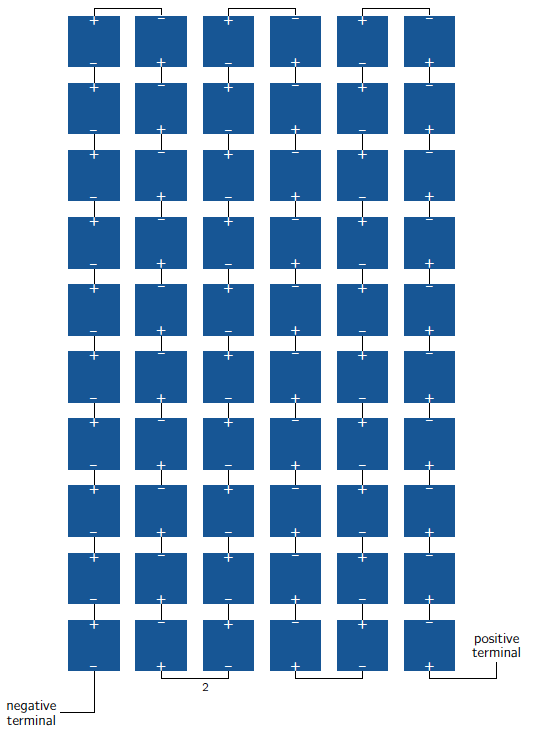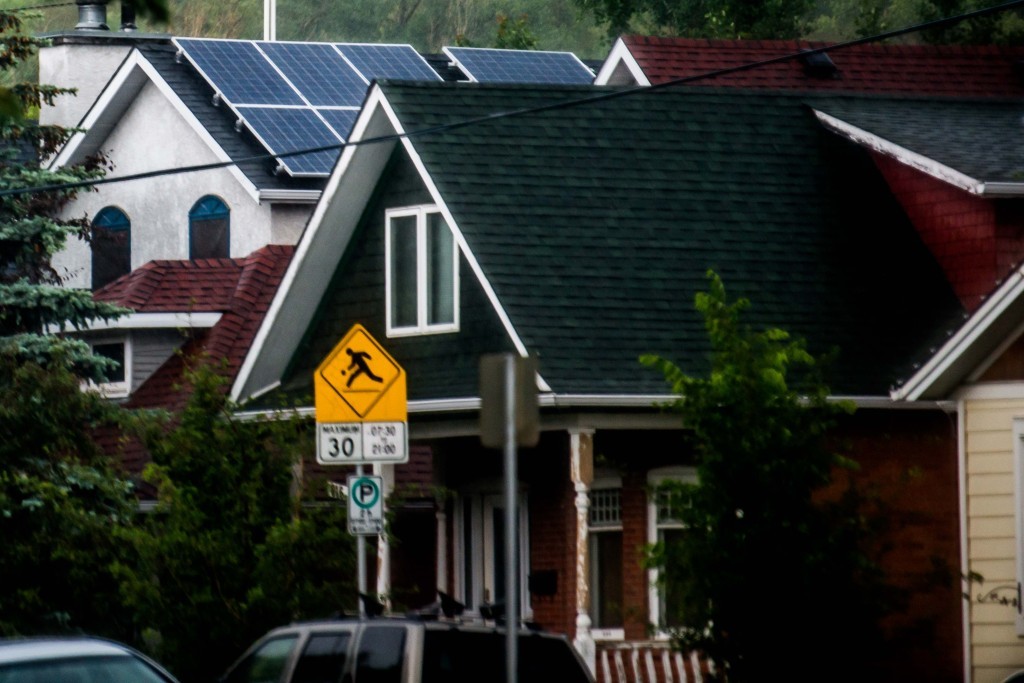In this FAQ page we go through some general questions about installing and investing in grid-tied solar power systems. Please contact us if you have any other questions not answered below.
[custom_headline type=”left” level=”h2″ looks_like=”h3″ accent=”true”]About solar power systems[/custom_headline] [accordion id=”my-accordion”] [accordion_item title=”What is the difference between a solar cell, module and panel?” parent_id=”my-accordion”]A solar module is what people and news articles commonly refer to as a “solar panel”. A standard 60 cell solar panel is about 5.5 feet tall, 3.5 feet wide and weighs about 40lbs (1.6m by 1m, 18kg). It is made up of 60 identical solar cells connected in series to one another:

A standard 60-cell solar module contains 60 solar cells connected in series.
The carbon payback period of a grid tied solar power system depends on several factors including how much sunlight the system receives and the energy that was invested in manufacturing, assembling and installing the solar modules, inverters, railing, and the nuts and bolts that go into a system. Some reports have been published by the National Renewable Energy Laboratory in the US and based on their average insolation (1,700kWh of sunlight per squared metre per year and other standard assumptions) it takes between 3.5 and five years. Keep in mind that solar modules (commonly referred to as solar panels) have a performance warranty of 25 years.
[/accordion_item] [accordion_item title=”Are solar panels tested against hail and snow?” parent_id=”my-accordion”]Silicon solar modules (commonly referred to as solar panels with blue cells) we provide are installed to the international standard (IEC 61215), which includes a variety of mechanical criteria. The front glass used to make solar modules is tempered, 3.2mm thick, and required to withstand the impact of a 25mm hailstone at impact speeds great than 80km/hr. The punishing hail and snowstorms of Alberta don’t stand a chance. In this article we discussed the affect of snow on solar production in Alberta. Below is a video showing how a large hailstone is simply crushed upon impact on the panel’s tempered glass.
[/accordion_item]
[accordion_item title=”What is the difference between a micro-inverter and a string inverter?” parent_id=”my-accordion”]String inverters processes output from a series of panels, known as strings, or a combination of strings, whilst a micro-inverter processes the output one one or two (sometimes three and four) solar panel. Micro-inverters are geared towards relatively small (<5kW) installations. They allow for greater design flexibility, and allows for each module to produce as much power as it optimally could.
- maximum number of Maximum Power Point Trackers Each – optimizes the output of the solar module that it is connected to. That means solar modules can be installed on any surface without limitation and without affecting the output of other modules. A string inverter on the other hand requires to be connected to a minimum number of modules, and has one or two MPPTs. Therefore the modules can’t be facing more than two different directions.
- no power interruptions or shading worries Other modules will continue to generate energy uninterrupted even if other panels (or faulty micro-inverters) are faulty or shaded.
- individual module monitoring You can monitor the performance of each individual module. With a string inverter you only monitor the performance of only two inputs of strings (or combination of strings).
- lower initial cost – easier to upgrade Although string inverters have a lower installed cost per watt, they require a higher initial input (10+ modules) and therefore have a higher initial cost than a micro-inverter. Micro-inverters allow you to easily expand your capacity in the future with however many more modules you want to add.
- no space, no noise Micro-inverters are installed on the roof and rely on natural convection for cooling. A transformerless string inverter weighs about 50lbs and requires a cooling fan.
You can read more about our products here.
[/accordion_item]
[accordion_item title=”How long will the system last?” parent_id=”my-accordion”]
Some of the earliest solar power systems that were installed in Europe in the late 80’s are still working today. Almost all commercially available solar module have a 25 year performance warranty, and some are starting to be warrantied for 30 years. Inverter manufacturers provide 10, 15 and 20 year warranties, some which can be extended.We expect the systems to be in service for at least 25 years.
[/accordion_item] [/accordion]
Alberta’s combination of clear skies and cold temperatures make it Canada’s “hot” spot for solar power. Read more about Alberta’s solar potential here.
[/accordion_item] [accordion_item title=”How much does solar energy cost in Alberta compared to grid energy?” parent_id=”my-accordion2″]Solar power systems in Alberta can provide energy at a lower rate than what utilities are charging. To be able to compare the cost of energy that a solar power system delivers with what utilities are charging we calculate its levelized cost of energy (LCOE). LCOE is a power system’s average cost of generating one unit of energy. Solar power systems depend on a renewable resource and are essentially maintenance-free, and therefore have no operating costs. Therefore a solar power system’s levelized cost of energy will depend on its installation cost (together with interest) and its energy output. Read more about solar power economics here.
[/accordion_item] [accordion_item title=”How many panels do I need to install?” parent_id=”my-accordion2″]Because you are still connected to the grid, the number of solar modules (commonly referred to as solar panels) to install is completely up to you. You can install four, 10, or 20 modules, or you can go all out and install a net-zero solar power system that generates as much energy you consume over the whole year. We generally don’t recommend installing anything smaller than eight modules for a residential rooftop system so fixed costs involved with an installation such as engineering, permitting, and labour are minimized.
[/accordion_item] [accordion_item title=”Why aren’t there any batteries included in the system?” parent_id=”my-accordion2″]The simplest and most cost-effective way to harness solar energy is with a grid-tie system. A grid-tied system allows you to use solar power when it is available during the day, and grid power when it isn’t, sparing you a huge cost in batteries, or from meeting any power requirements. Batteries are bulky, expensive and require regular maintenance, and won’t last as long as panels or inverters. Therefore we don’t recommend battery back-up systems unless you live or work in an area that experiences frequent power outages, and even then there might be more affordable solutions (such as back-up generators) than storage batteries.
[/accordion_item] [accordion_item title=”Will I still be vulnerable from increases in energy prices without batteries?” parent_id=”my-accordion2″]Grid-tied micro-generator receive credit for their exported energy at the same rate at which they are charged for consumed energy. Therefore micro-generators leverage grid consumption with a grid-tied system without having to install batteries. The rate of leverage you will have will depend on the ratio of your generation to consumption. Therefore the bigger your solar power system is the less vulnerable you will be from fluctuations and increases in utility rates.
[/accordion_item] [accordion_item title=”How big of a system do I need to make my power bills go to zero?” parent_id=”my-accordion2″]The Micro-Generation Regulation caps the size of a micro-generation system by the client’s annual consumption. For example if a service consumes 6,000 kilowatt-hours (kWh) of electrical energy every year from the grid then it can only host a micro-generation system that generates up to 6,000kWh per year. Furthermore there are fixed costs which range from 20-40% of the total bill (depending on your consumption and retail rates, daily distribution tariffs, retailer administrative cost and mark up etc.) so unfortunately you are not able to diminish your bills, but with a net zero system (that generates as much electricity as you consume) you can minimize your bills to the maximum extent possible under current regulation.
The only way to rid yourself of these fixed costs is by disconnecting your electricity service completely and install an off-grid solar power system. Most homes don’t have enough roof space to install enough panels to match their consumption in the winter period , and even if they did they would still require an expensive battery bank and/or a backup diesel generator that could easily double the installation cost of the system. So we generally don’t recommend any off-grid or hybrid systems for residential installations unless there are frequent power outages in which case a small and inexpensive battery bank can offer a quick and simple solution.
[/accordion_item] [accordion_item title=”How will solar power affect the selling price of my home?” parent_id=”my-accordion2″]By investing in solar you are reducing your expenses and improving the value of your property. A study by the Department of Energy’s Berkley Lab looked at how roof-top solar power systems affected the selling price of homes in California. Based on the average size system they calculated in their database which was 3.1kW, they found that homes sold for $17,000 higher than their purchase price.
[/accordion_item] [/accordion]